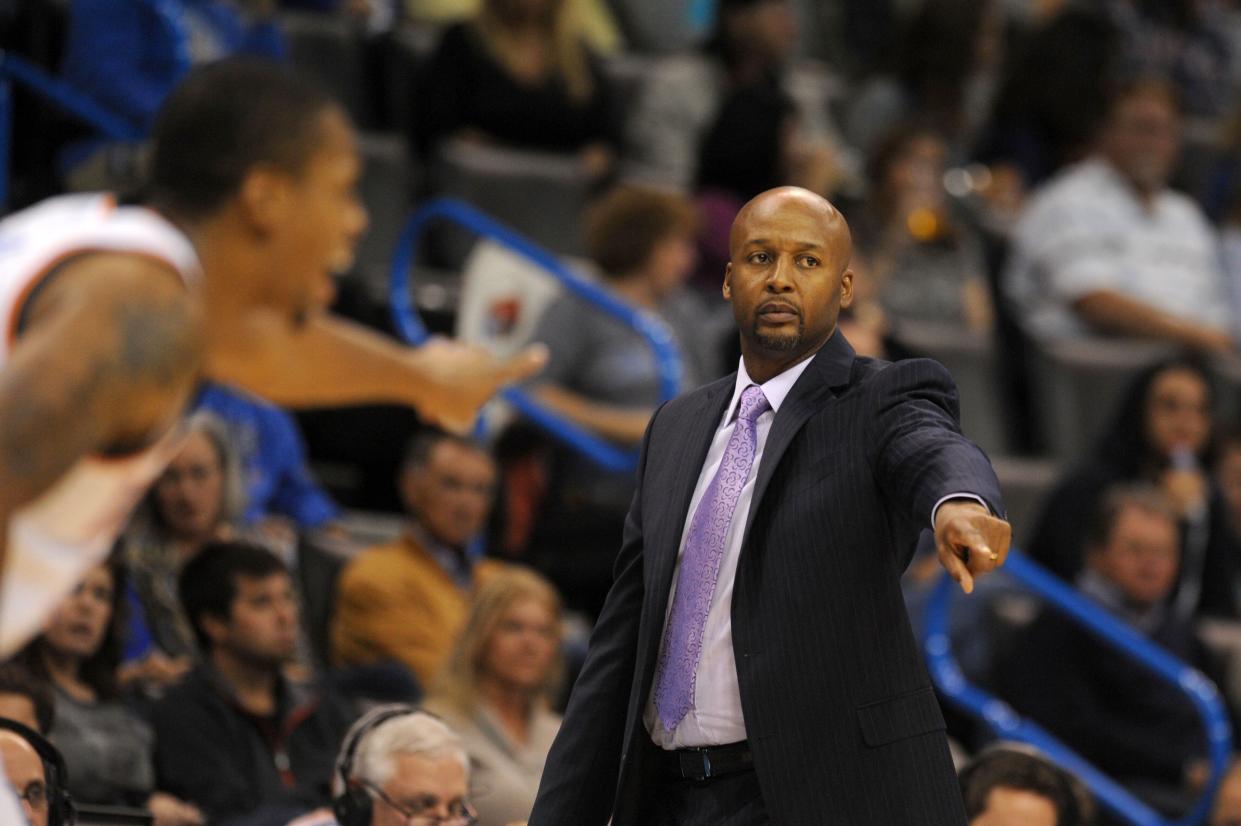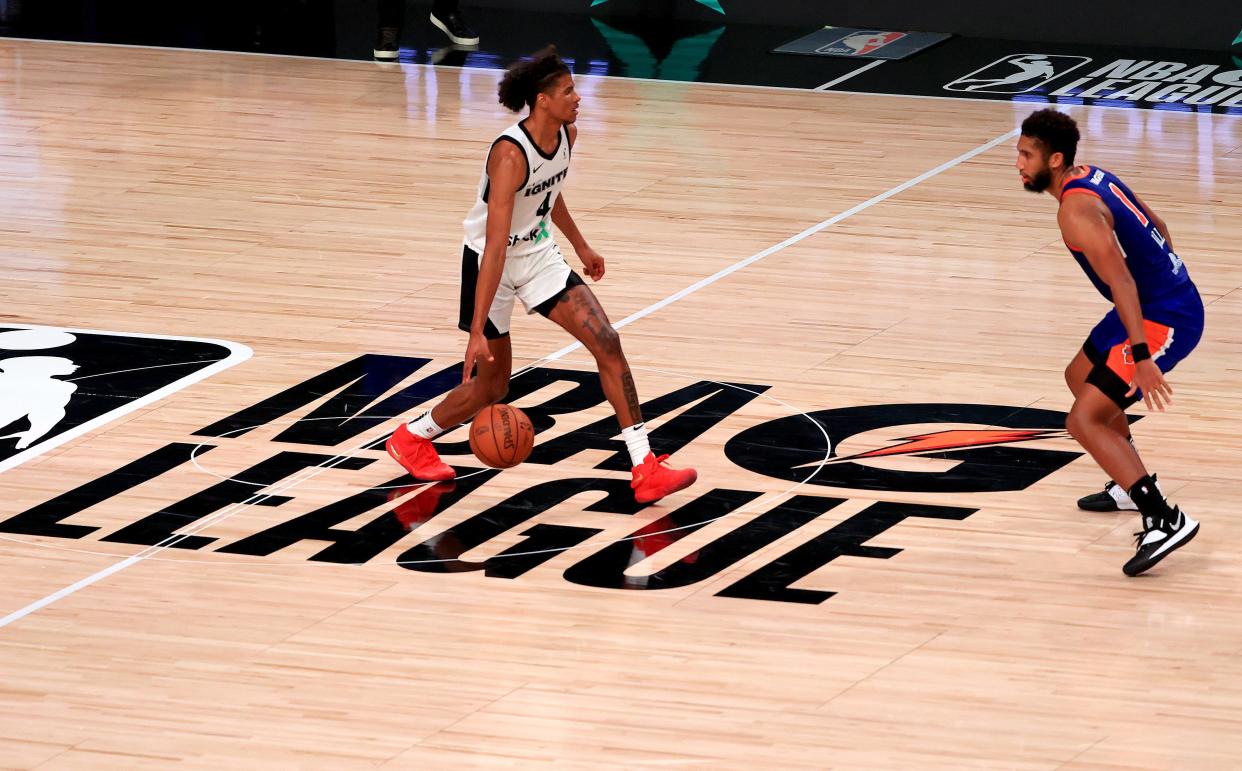How Jalen Green and Jonathan Kuminga could make G League Ignite best option for prospects
With nervous anticipation, the aspiring NBA prospects will soon experience something that will shape their career significantly.
When the NBA Draft starts on Thursday, Commissioner Adam Silver will announce each team’s draft selection. Not only will that reveal the prospect’s perception among a potentially star-studded class, it will also offer a window into the journey a prospect might face on a rebuilding team. Unlike in past years, though, this upcoming draft will also yield more clarity on another question that intrigues prospects, teams and the league office.
After completing its inaugural season, will the G League Ignite team become the best option for prospects to prepare for the NBA? Or will playing in college or overseas still remain the more conventional route?
“What the G League is becoming is the place for the best young basketball players in the world,” G League Ignite president Shareef Abdur-Rahim told USA TODAY Sports. “I don’t know what form it will take or continue to take. But we’ll continue to be a platform for the best young basketball players in the world.”
In just its first year, the G League Ignite attracted a handful of prospects that leaves the organization expressing optimism about its future.
The team featured Jalen Green, who is expected to land No. 2 (Houston Rockets) in this year’s draft. The team also featured Jonathan Kuminga, whom mock drafts peg as being selected somewhere between the top five or top 10. And the team also showcased prospects expected to be selected later in the draft (Isaiah Todd, Daishen Nix) and international players (Filipino center Kai Scott, Indian forward Princepal Singh).
As for next year? G League Ignite already has commitments from two five-star recruits (Michael Foster Jr. and Jaden Hardy), an Australian prospect that played in the NBA’s Global Academy (Dyson Daniels) and an early graduate that has already committed for two seasons (Sterling Henderson).
“It’ll prepare guys for the NBA. But I don’t get into comparisons with college or overseas,” Abdur-Rahim said. “What we’re trying to do is unique.”
Why Green and Kuminga joined the G-League Ignite team
What makes the G-League Ignite team unique?
Well, the one-year program offers up to six-figure salaries to prospects that otherwise could not make that money in college, even though the NCAA announced an interim policy that allows student athletes from all three divisions to monetize their name, image and likeness, often referred to as NIL.
Based in Walnut Creek, Calif., the G League Ignite team features a roster that includes both future draft-eligible prospects and established professionals eager to serve as mentors. The G-League Ignite played a 15-game season against other G-League teams on a campus bubble in Orlando (8-7 in regular season, 8-8 overall), but will also plan to play international teams once pandemic restrictions are lifted. And unlike in the NCAA, the players have no restrictions on how much time they devote to practices, weight-training sessions and film study.
“The G League Ignite is like playing in the States, while overseas is a whole different game. The G League is one step ahead of college,” said Green, who had decommitted from Auburn. “You learn how to become a pro on and off the court early.”
The G League Ignite program has both a president (Abdur-Rahim) and coach that had played in the NBA (Brian Shaw). Abdur-Rahim could share directly about playing one year at the University of California, being selected as the No. 3 pick in the 1996 NBA Draft and then carving out a 13-year career. Shaw could talk about winning three NBA titles with Kobe Bryant and Shaquille O’Neal and how he thrived as a role player during a 14-year NBA career.

The value went beyond Shaw sharing stories about Bryant, whom Green and Kuminga considered one of their idols. Shaw also had stints both as an NBA assistant (Lakers, Indiana) and head coach (Denver Nuggets), giving him insight both on how to run a practice and follow an NBA playbook.
Knowing that their success in the NBA goes beyond what happens between the lines, the G League Ignite has also placed a heavy emphasis on other things. It has hosted former and current NBA players to speak (Jamal Crawford, Darius Miles, Quinn Cook) as well as parents of NBA players. It has also held information sessions involving media training, financial literacy and sleep therapy.
So after growing up in Congo and moving to the United States at 13 years old, Kuminga became intent on tackling a new challenge.
“I know as long as I stayed disciplined with my work, I stayed healthy and guys would protect me, things would work out for me in basketball,” Kuminga said. “Me going to the G League, I never really worried about it. If I worried about it, I would never make that decision.”
How NBA front offices view Ignite
Too early to say whether those around the NBA think the same way.
One NBA executive expressed concern that players with the G League Ignite team seem more compelled to showcase themselves as if they were “on an extended AAU team” than they would even in just one year of college.
“I don’t know coaching wise how the coaches will hold players accountable for different things,” the NBA executive said. “A college coach knows with a one-and-done that they have to do what they're telling him to do. Otherwise, he’s not going to play and then he won’t become a one-and-done.”
Another NBA executive countered that behavior still happens in college basketball with coaches feeling pressure to cater to the one-and-done player because of his talent level. The person also noted that the NBA benefits because it can oversee how the G League operates.
"It’s not fair to tell colleges how to prepare players for the NBA. But I think it’s fair at the G League level, where there is more of an NBA focus so that those players are prepared for the NBA,” the NBA executive said. “It gives us a big benefit so that players in that program have an exposure level to higher-level coaching and higher-level competition.”
Amid the uncertainty, it appears the benefits and challenges simply depends on the player’s skillset and readiness to devote more of his focus to basketball.

“For selfish reasons, I think it’s good. But for the education, growing up and lifestyle, it can be overwhelming for some of these young guys that don’t have the same structure as they would in college,” an NBA scout said. “But the financial component is hard to turn down. When you offer a kid hundreds of thousands of dollars instead of going to college for one year, it’s hard to pass up.”
So where do things go from here?
Abdur-Rahim and others around the NBA expressed uncertainty given the small sample size and the fluid nature of the sport’s developments. Nonetheless, Silver said during All-Star weekend he has had talks with National Basketball Players Association executive director Michele Roberts about potentially voting against the so-called one-and-done rule that requires a player to spend at least one year in college or overseas before joining the NBA. The NBA and NBPA could make those changes in their labor deal as early as 2023.
“We recognize that is not for everyone,” Silver said of G League Ignite. "There may be the player who is not at that skill level yet where he’s been identified as sort of a clear prospect. There are other young people who grow a lot at that age or whatever else, or want to go to college. To me, options are a good thing.”
Will G League Ignite become the most enticing option? That could also depend on how Green and Kuminga fare early in their NBA careers.
An NBA scout envisioned Green as being in the league “for a long time” after becoming impressed with his athleticism, scoring and defense. So does Green, who believes he will win the NBA’s Rookie of the Year award and land on an All-NBA Defensive Team. Green only worked out for the Pistons and the Rockets since they have the No. 1 and No. 2 picks, respectively.
“I think I’m one of the best players in the draft, if not the best player in the draft,” Green said. “So with that being said, I feel I should work out for the highest team.”
Meanwhile, the same NBA viewed Kuminga with having the “highest upside” because of his 6-foot-8, 205 frame as an oversized wing. With Kuminga averaging 15.8 points albeit on only 38.7% shooting overall and 24.6% from 3-point range, the scout expressed optimism he will improve both his range and ball handling.
“I see myself in five years being the most talked about person in the league,” Kuminga said. “I’m not going to say I’m going to come into the league and have an impact right away … But I see myself after my career being in the Hall of Fame. I see myself after a couple of years helping my team to get to the Finals and win championships.”
First things first. After their names are called on Draft night, Green and Kuminga will stand on center stage eager to prove they took the best route to the NBA.
Follow USA TODAY NBA writer Mark Medina on Twitter, Facebook and Instagram. Sign up for USA TODAY's various subscription deals.
This article originally appeared on USA TODAY: Draft success of G League prospects could cause others to bypass NCAA
